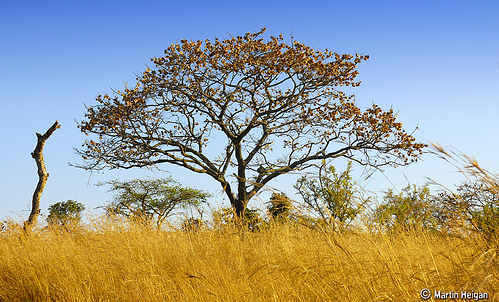
Pterocarpus angolensis è un albero deciduo originario dell’Africa meridionale e orientale, in grado di adattarsi e crescere in una grande varietà di località e condizioni ambientali. Si tratta di una specie minacciata a causa del suo legno pregiato (“Blood wood, o Kiaat”) e dei cambiamenti di uso del suolo. I modelli di distribuzione delle specie potrebbero fornire informazioni utili sulla sua distribuzione e sulle sue necessità ambientali, aiutando nella gestione sostenibile di questa specie a rischio.
In un nuovo studio pubblicato di recente su Forest Ecology and Management, un gruppo di ricercatori (fra cui Antonio Trabucco della Divisione IAFENT del CMCC) ha cercato di fare una stima della distribuzione potenziale, effettiva e futura della pianta P. angolensis. È stata quindi prodotta una mappa di distribuzione con un buon potere discriminante per la specie in esame, che mostra come la presenza e la diffusione di P. angolensis siano principalmente influenzate dall’entità delle piogge estive, dalla temperatura minima registrata in inverno e dalla stagionalità delle temperature.
Inoltre, i cambiamenti climatici possono ridurre l’areale della specie in modo considerevole, specialmente nelle regioni occidentali, mettendo a rischio la presenza della specie in Namibia e in Botswana.
L’abstract dell’articolo:
The deciduous tree species Pterocarpus angolensis occurs in the dry woodlands of southern Africa and grows under a broad range of environmental conditions. It is threatened by overharvesting due to its valuable timber (Blood wood, Kiaat) and by land use changes. Information on the most suitable environmental conditions for the species is often old and anecdotal, while available data on its occurrence refer to range extent and not to distribution. Species distribution models (SDM) could provide more accurate information on distribution and environmental requirements and thereby assist sustainable management of this tree species.
Maxent models were developed to estimate the potential, realised and future distribution of P. angolensis and to identify detailed environmental requirements. Occurrences data of the species were sourced from herbaria and other published sources; environmental data from global GIS databases. Relevant environmental predictors were selected through a jack-knife test of the first model runs. The addition of information on competing species, fires and deforestation was tested to determine realised distribution. Model quality was evaluated with an independent presence-absence dataset. The model was projected with two different climate change scenarios to study their effect on the distribution by 2080.
Results show that a potential distribution map can be obtained with good discrimination of the presence of the species (AUC 0.83) and fairly good calibration (correlation coefficient 0.61). Range extent and environmental requirements are more detailed than those described in literature. The distribution of the species is mainly influenced by the amount of summer rainfall, by the minimum temperature in winter and by temperature seasonality. Potential and realised distributions are very similar, with Madagascar as major exception where the species can grow but does not occur. Adding the fire history of the last 13 years or the distribution maps of potentially competing species as predictor variables did not improve the distribution model. It did illustrate that P. angolensis is mainly found in areas with annual fire frequency below 45% and that only a few of the tested species show signs of competition. Using a forest cover map improved the realised distribution slightly (Kappa coefficient 0.64). Climate change can decrease the species range considerably, especially in the west, threatening species existence in Namibia and Botswana. On the other hand, the species’ occurrence is predicted to increase in Zambia.
Leggi la versione integrale dell’articolo:
De Cauwer V. , Muys B., Revermann R., Trabucco A.
Potential, realised, future distribution and environmental suitability for Pterocarpus angolensis DC in southern Africa
2014, Forest Ecology and Management, Volume 315, Pages 211–226, DOI: 10.1016/j.foreco.2013.12.032


